
|
|||||

|
|
See my new site!
This watercolor sketch shows my design for a new lobby mosaic in the Eagle Hill School Cultural Center. The school is located in a pastoral section of western Massachusetts surrounded by pine forests. The design captures the tapestry like quality of light and shade under the forest canopy. The deep perspective looking up at a glowing sky offers a visual experience of transformation and transcendence. This angled view also provides a changing architectural experience as viewers move along the stair and balcony of the adjacent two-level theater lobby. |
|||
| 'Aspire' (For Matt). Eagle
Hill School Cultural Center. Hardwick, MA. |
|||||
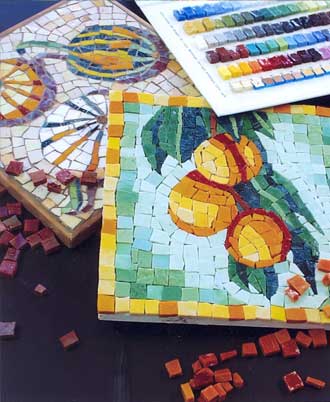 |
|
Glass smalti is one of the oldest and most beautiful of mosaic materials. Its small size, wide range of colors, and glassy brilliance make it an ideal choice for creating detailed, vibrant mosaics. It is often used in large mosaic murals to create complex images with painterly effects, in locations where permanence is required. The panels shown here are portable smalti mosaics that I created as teaching samples for my students in the Traditional Mosaics Classes that I teach in my studio. |
|||
|
Smalti panels, 10" x 10", and sampleboard.
|
|||||
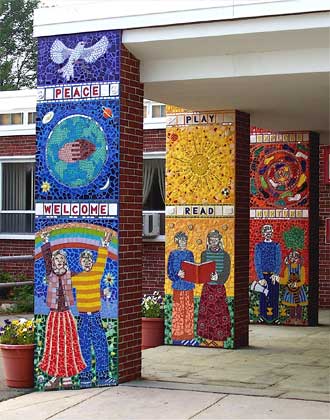 |
|
Architectural elements provide an ideal site for mosaics. At the Claypit Hill School, three brick columns support an entry porch to the school. All four sides of each column have been decorated with mosaics that create changing compositions around the columns. The letter bands are made of handmade clay tiles that spell out school values. The figures’ faces and hands are made of mirror, reflecting the real faces of the children at the school. This is a vibrant, permanent public artwork that creates a welcoming entrance for the school. |
|||
Claypit Hill School Entry Columns. Wayland,
MA. 12' high x 3' wide (each column). |
|||||
 |
|
I often use mosaics to create collaborative murals, like this one at the Cottage Street School. This project was supported by the Massachusetts Cultural Council, under the auspices of the ‘Creative Teaching Partnership Program’. I was invited into the school as an Artist-in-Residence to create a permanent artwork in the school lobby. The mosaic process is well-suited to group work, where a range of tasks are taken up by people of different levels of skill and interest. The extensive use of mirrors and brightly colored grouts creates a dazzling display. |
|||
Cottage Street School Lobby Mosaic. Sharon,
MA. 8' high x 44' long. |
|||||
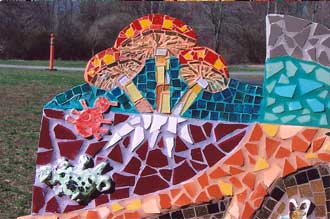 |
|
This detail of mushrooms growing next to the roots of a tree (from ‘The Underground’ panel of the “Tribute to the Places of Concord’ in the Alcott School), shows an interesting palette of materials: two small ceramic insects were created by Third graders from handmade clay; Venetian Glass mosaics decorate the bright mushroom caps; Mexican smalti and cracked ceramic tile create the earth and roots. Hand tinted grout finishes the artwork. |
|||
| Alcott School
Staircase Mosaics. Concord, MA. Detail of one of eight panels. |
|||||
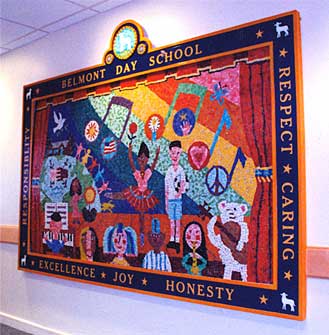 |
|
This mosaic mural was created as a centerpiece for the lobby of the Belmont Day School’s new theater building. It is made from Mexican smalti, and bordered by a painted frame with mosaic details. Elementary school students contributed design drawings that I integrated into this scene of the school stage with student performers and audience. The mosaic was made collaboratively in the art classroom over the course of one month. |
|||
| World Theater Mosaic. Belmont
Day School. Belmont, MA. |
|||||
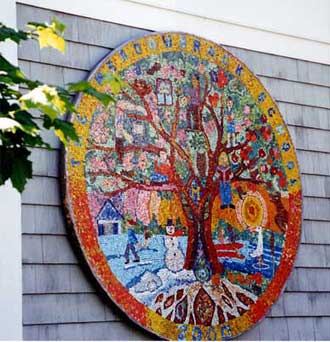 |
The theme of The Four Seasons combines with a Tree of Life in this twelve foot diameter school mosaic, installed on the playground wall of an elementary school. This mosaic was designed and made by students using Mexican smalti. This beautifully colored, easily cut glass mosaic is an ideal material for young artists, who work collaboratively to create the image in a jigsaw-like process that creates a Pointillist mural. |
||||
'The Four Seasons at Meadowbrook'. |
|||||
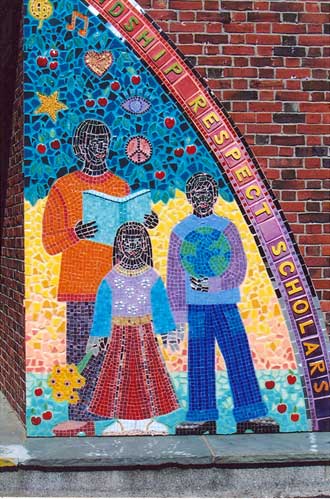 |
This is the right panel of the arched entryway mosaic created by me with the students of the Happy Hollow School in Wayland, Massachusetts. My role was the school’s Artist-in-Residence. The stylized figures gave us room to be creative with materials: the characters clothing is created from Venetian glass, (a ¾” square cast glass tile available in 100’s of colors) which was cut by students into intricate patterns. The faces, hands and hair are made from mirror, reflecting viewer’s faces. Backgrounds are made of cracked ceramic tile with colored grout. The border is vitrified clay tile, handmade by the students and fired in the school kiln. |
||||
Happy Hollow School Entryway
Mosaic. Detail of right side. Wayland, MA. |
|||||
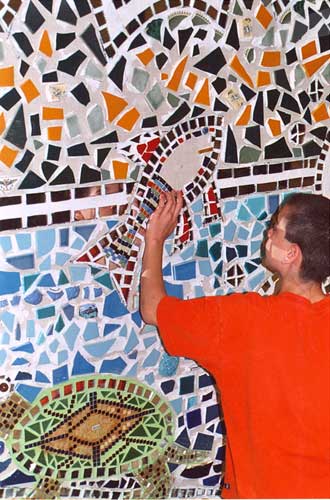 |
This progress photo shows the Cottage Street School Mosaic before we started the grouting process. A fifth grader is creating a fish directly on the wall. The backgrounds are made from cracked ceramic tile spaced widely, which allows students to work loosely and the leftover spaces become filled with the brightly colored hand tinted grouts as the final step of the work. |
||||
'In Our Own Backyard'. Cottage Street School. Sharon,
MA. |
|||||